
This month we’re taking you back to the nice, warm days of summer when heat-loving varieties, in particular, gave visitors to the 10th annual Sawaya Garden Trials a very rewarding show. On the mid-August day of our grower open house, umbrellas were used to protect against the sun and not any rain!
This month we’re taking you back to the nice, warm days of summer when heat-loving varieties, in particular, gave visitors to the 10th annual Sawaya Garden Trials a very rewarding show. On the mid-August day of our grower open house, umbrellas were used to protect against the sun and not any rain!
The summer still featured a number of rainy nights, but fortunately many of the days were still sunny and warm. It is amazing how fast the recovery is for some plants, and how there is virtually no setback at all for them; others, however, looked like they went through the “heavy duty” cycle in the washing machine. These weaker plants generally took five to seven days to recover, mainly from shattered flowers, with botrytis getting a hold of the rest.
The main purpose of our trials is to see the varieties that perform best in our climate (southwestern Ontario). For the past 10 years, we have seen some genus perform especially well and others struggle. Calibrachoa production, for example, has increased more than 1,000-fold over the past few years, not only in Ontario, but across Canada. This dramatic increase is due to its excellent garden performance, and the excellent show it puts on from early spring to late fall as long as we are able to fertilize on a regular basis with every watering.
GARDENING SUCCESS ENSURES REPEAT CUSTOMERS
In my personal experience, ivy geranium in Ontario is a total loss as a garden performer. We see that hardly any of the regular types were produced this year, while the interspecific varieties, such as ‘Caliente’ and balcony types, have been on the increase. After all, we are growing plants for the ultimate consumer, and their success is our success!
All trial plants are donated and sold by Norfolk General Hospital volunteers right from the trial gardens site. The people that come are amazed by the quality of the plants, and are happy to pay $20 a pot for annuals, even on Aug. 20. So why are gardeners not getting the full potential beauty out of their plants?
The answer is simple: we are not communicating the information effectively to the ultimate consumer. Unless we are planning to shrink our sales by 2.5 per cent every year, we better get together with our buyers (stores and garden centres) and educate the consumer. This is in addition to doing our homework in selecting the best garden varieties.
| Here are some the steps to increase sales: | |
| • | Only grow garden-proven varieties. |
| • | Sell the plants in larger containers than you are used to growing them; i.e., flats material in much larger cells or 4” pots, and 4” material in 6” pots. The rule of thumb is that if you have to apply growth regulators more than once to ensure the plant fits within the container, then the container is probably too small for the plant. Examples include dahlia, blue salvia, Profusion zinnias and gazinnia, to mention a few. |
| • | Plant in a good potting media and avoid weird additives. Extending the plant 12 hours or a day before watering creates a false expectation for the consumer. |
| • | Top-dressing containers with slow-release fertilizer could be a setback for varieties that cannot take a heavy dose of fertilizer all at once, and that will happen once we get high temperatures because slow-release fertilizers are released based on temperature. |
WHY NOT OFFER A LIQUID FERTILIZER BONUS?
| • | Provide liquid fertilizer free, as a bonus, when they buy your plants. Mix it in 200-litre barrels in concentrated levels so that consumers can dilute it 1,000 times to end up with a fertilizer in the range of 150 ppm. |
| • | If we don’t do anything else, we must sell simplified drip kits so the homeowner can water his or her plants effectively and regularly. By doing this, I guarantee plant sales will increase three to four per cent rather than decrease by two to three per cent each year. People who visit our trials ask about our drip system and I tell them where to buy it and the simple steps needed to put it together. Those who do install it make it a point to come back and thank me for the hint. They also tell me how they are going to buy many more plants because they know the plants are going to do very well without any more work. |
| • | Get involved in advertising plants and their benefits. In this industry, there is no sitting on the fence. If we are not part of the solution, we are part of the problem. |

|
|
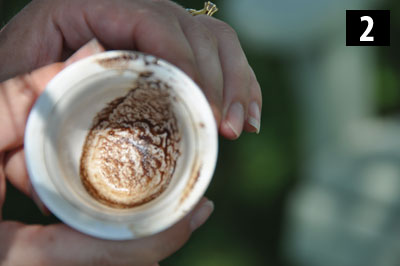
|
|
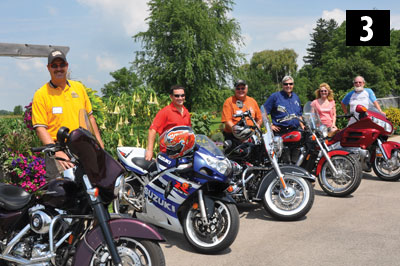
|
|
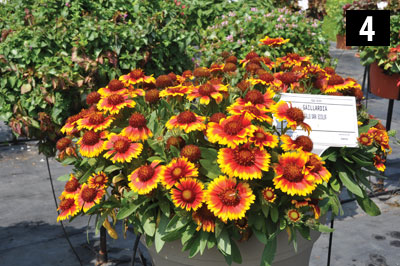
|
|
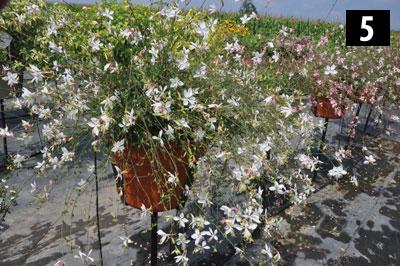
|
|
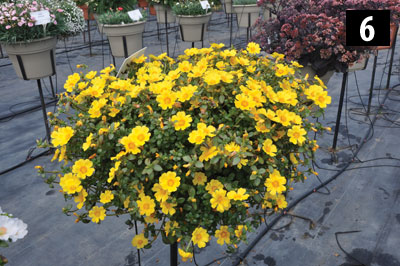
|
|
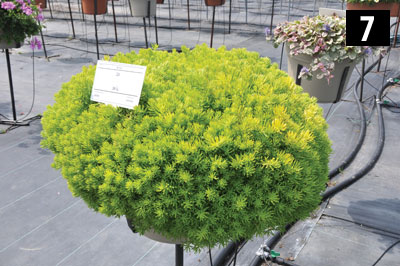
|
|
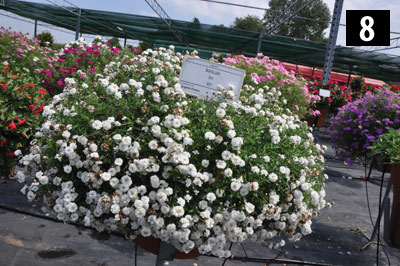
|
|
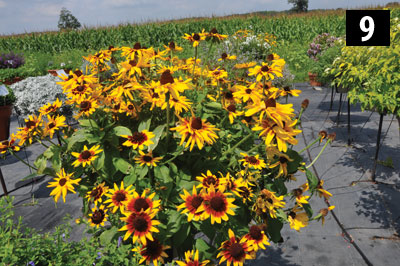
|
|
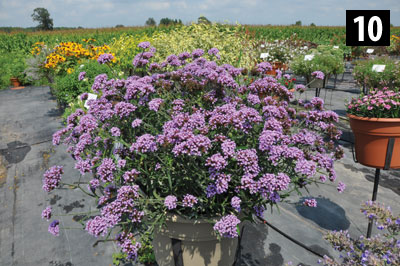
|
|
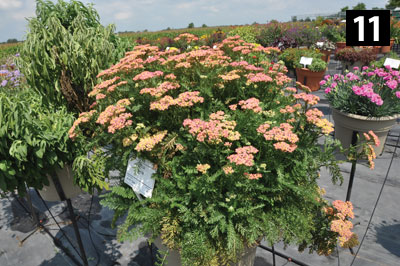
|
|
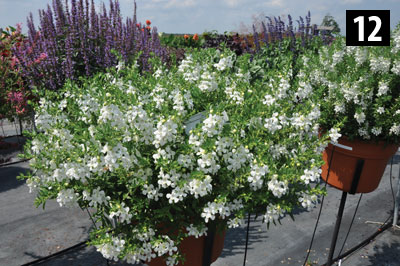
|
|
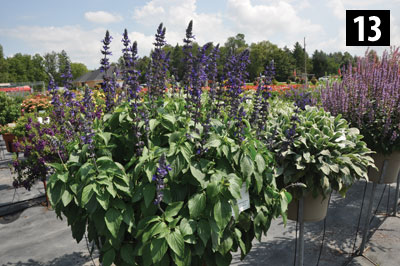
|
|
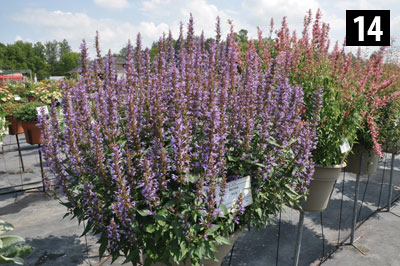
|
|
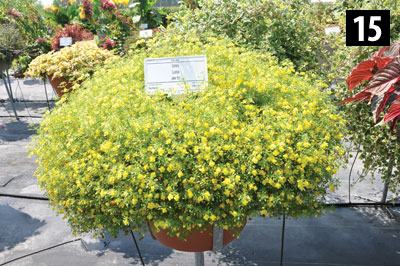
|
|
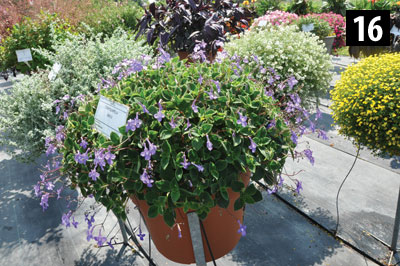
|
|
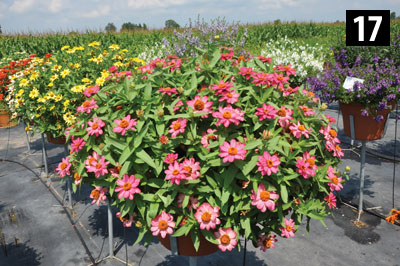
|
|
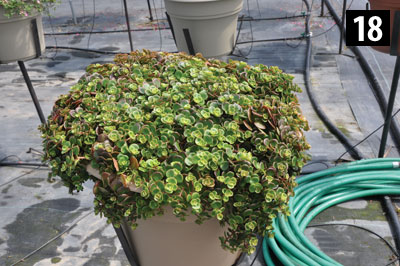
|
|
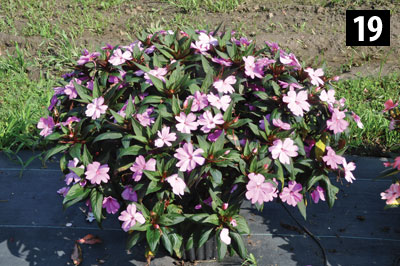
|
|
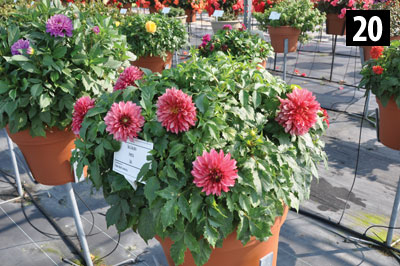
|
|
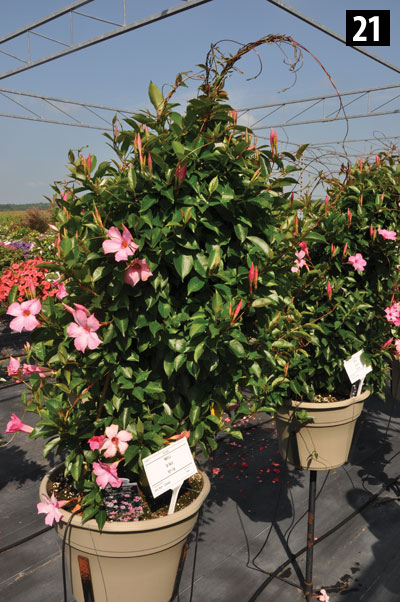
|
|
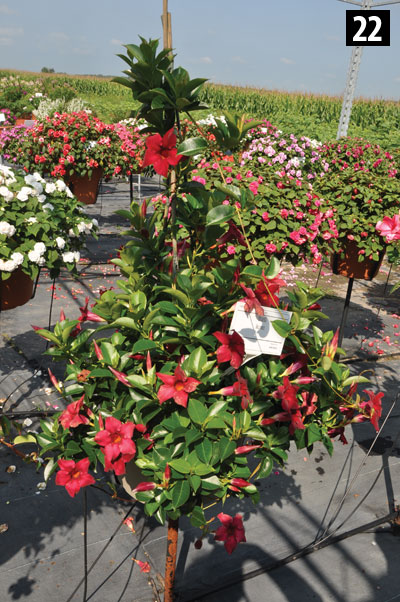
|
|
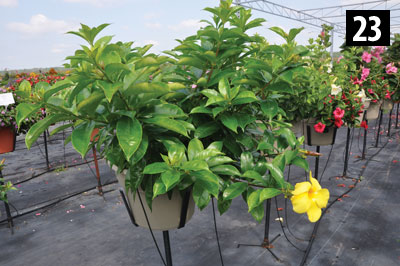
|
|
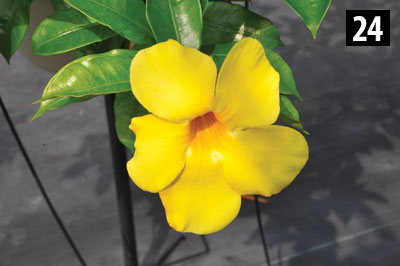
|
|
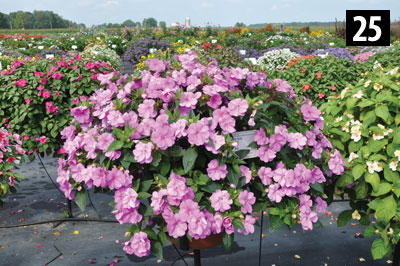
|
|
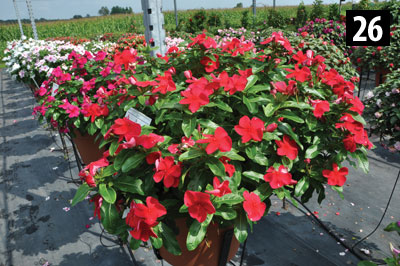
|
|
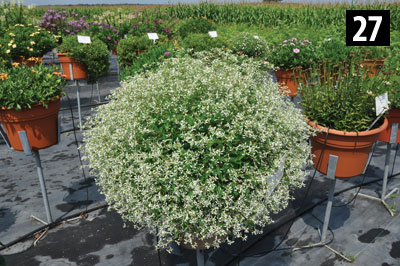
|
|
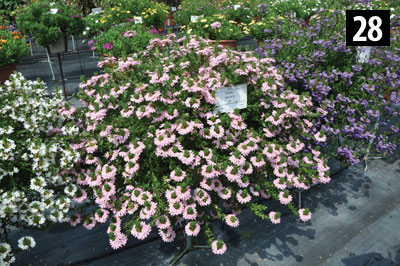
|
|
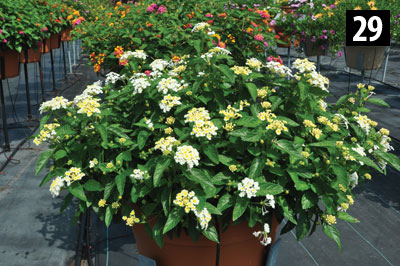
|
|
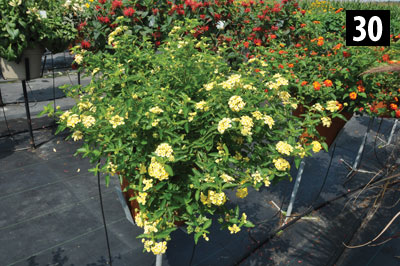
|
|
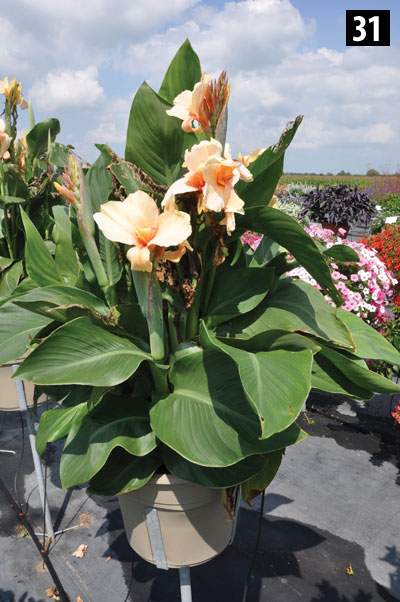
|
|
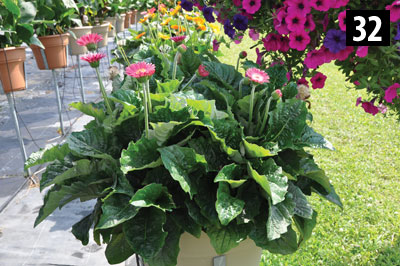
|
|
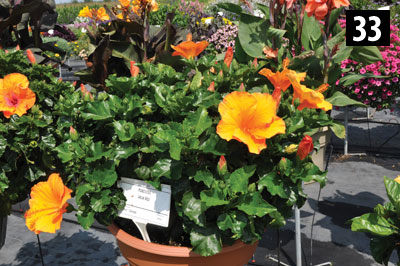
|
|
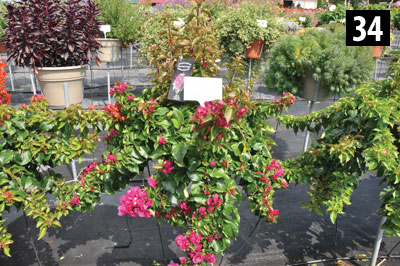
|
HIGHLIGHTS FROM THIS SUMMER’S TRIAL
Here are some highlights from our trials this summer.
It is not practical to share with you the performance of all 2,200 cultivars, so this year I decided to pick a few cultivars that were excellent performers while being drastically under-represented in the market. Next month, I will list the top 10 performers, and the ever-popular mixed container pots and hanging baskets.
New for this year’s open house we had a fortune teller who could tell the future. Cole Cacciavillani jumped at the chance (1) and in no time, one of the predictions came true – that he would soon be taking a trip of approximately three hours! That’s how long his drive home would be! All that was needed were the last grinds from his now almost empty Lebanese coffee cup (2).
Yes, the tradition goes on and the bikers returned to the trials (3). What could be better than mixing business with your hobby?
The perennial part of our trials is getting larger every year. Many of these perennials flower the whole summer. Gaillardia ‘Gallo Dark Bicolour’ (4) is a colourful perennial that hardly needs any deadheading, and performs well in hot or cool weather.
Gaura ‘Stratosphere White’ (5) is one plant that gets better looking with age. The larger it gets, the better the show it puts on. Our problem is that we grow gauras in 4” pots that don’t do it any justice. Grow it in large pots (12-14”), and let it show its beauty and durability.
Portulaca ‘Pazzaz Jumbo Yellow’ (6) provides an excellent show the whole summer. It requires no deadheading. Drought-tolerant, it is also able to handle overwatering. It is perfect for cottages where watering it well once a week will keep it alive. The Pazzaz series comes in many colours to suit any outdoor design.
‘Lemon Ball’ (7) is an excellent sedum. Like portulaca, it is drought tolerant. Try planting different succulents together and market them as being great in drought conditions, ideal cottage planters, or perfect for those who don’t use plant sitters to keep their plants alive while they’re away.
Achillea ‘Gypsy White’ (8) is excellent in combinations. It can stand the heat much better than bacopa and has large flowers that last a long time.
Rudbeckia ‘Denver Daisy’ (9) is another perennial that flowers throughout the summer, in hot or cold temperatures and in rain or shine conditions. It is excellent in large containers, beds or combinations. Make sure to plant rudbeckia early because it needs short days to bulk up; in long days it is easy to flower and the plants will not have much body.
‘Buenos Aires Lollipop’ (10) is the best garden performance plant, in my view. Gardeners ask for it every season. It is easy to produce and cost-effective, but needs to be sold late in the season because it needs long days to flower.
Achillea ‘Pineapple Mango’ (11) is another perennial that flowers continuously. Achillea comes in many colours, and is excellent for large containers – alone or mixed – as well as in garden beds. Offer only in gallon-size or larger containers to best show its potential.
‘Carita Cascade White’ (12) is an excellent garden performer, like many other angelonias. The reason they don’t sell well is because we usually offer them in small 4” pots despite the fact they show their beauty much better in large containers where they really excel later in the season. Angelonia is also good in flowerbeds, especially the varieties with an upright habit.
Blue salvia have been popular for a long time, but the seed varieties like ‘Mystic Blue’ (13) flower much earlier and feature excellent foliage and sturdy stems. ‘Mystic Blue’ is good in combinations as a centrepiece, or in landscapes. It is excellent all summer long.
There are many agastaches on the market, but ‘Purple Haze’ (14) has better performance than any of the others I have seen. The flower tassel is long and in colour from top to bottom, providing an amazing show. ‘Purple Haze’ is good for large containers, landscapes or as a centre in mixed containers.
Scopario ‘Illumina Lemon Mist’ (15) is one of the varieties that have excellent performance but are not popular because there is no marketing behind them. Try ‘Lemon Mist’ in large containers, hanging baskets and in combinations. ‘Lemon Mist’ flowers the whole summer without deadheading.
Streptocarpella ‘Concord Blue’ (16), or any streptocarpella for that matter, is by far the best garden performer in partial shade, but it really blooms and excels in full sun. However, it is not popular for three reasons:
| Cold water on the leaves is a no-no, so drip or under-leaf watering systems are needed. | |
| The flowers shatter a lot, so growing them above another crop is not a good idea. | |
| And because there is no royalty, it is never advertised. Consumers don’t really know much about it. |
‘Zahara Coral Rose’ (17) is one of six colours in this zinnia series that showed excellent garden performance. The flowers lasted a long time before they needed deadheading. They are good in large pots (size 4” and up), mixed containers and landscapes.
Sedum ‘Coral Reef’ (18) is only one of the many succulents increasing in popularity when packaged right in mixed containers or large hanging baskets.
‘Sunpatiens Lilac’ (19) is one of seven colours in this compact series. It features an excellent garden show, and like all other impatiens, is excellent in full sun; the main difference is that it keeps growing throughout the hot summer. New breeding has garden performance as priority number one. Too bad consumer awareness is not there yet.
Dahlia ‘Dahlinova Hypnotica’ Coral (20) is one of 13 colours in this series known for its large flowers and vigorous plant habit. It is semi heat-tolerant, but is much more so than other dahlias. It has much better performance in flowerbeds than in large containers.
Mandevilla ‘SunParasol Pretty Pink’ (21) is a trailing member of the Parasol series. SunParasol does better with warmer temperatures and sunny days. It requires minimal care and is a top garden performer.
‘Dipladenia Voulivensis’ (22) is another series that has done very well in the trials. There are many sources of dipladenia mandevilla and most of them have excellent garden performance. It is critical to find varieties that flower early, and more important to find ones that hold onto their flowers the longest.
‘Allamanda Yellow’ (23) is a plant with ordinary foliage but an exceptional flower (24).
Impatiens ‘Trailing Fanfare Orchid’ (25) is one colour in this series that is very hardy in the sense that the plant can wilt until you would almost think it is dead; but then with one watering, the plant perks up without any yellow leaves or any side effects.
Vinca ‘Titan Dark Red’ (26) is an excellent colour in this series that is bred for disease-resistance. Almost all vinca do well in hot, sunny summers as long as they are disease-resistant. Vinca is not very tolerant for high salts, so a low fertility program will enhance its performance.
Euphorbia ‘Silver Fog White’ (27) is one of the many euphorbias on the market now. ‘Silver Fog’ is somewhat more compact than ‘Diamond Frost.’ Also, other euphorbias have different foliage colour, a higher flowers-to-leaves ratio, and different growth habits.
Scaevola is one of the first genus that started the vegetative garden plant explosion. However, for the last few years, its use slowed down, even though scaevola garden performance is second to none. The reason could be that growers don’t use it enough, either due to a lack of production knowledge, or because of the few extra production weeks needed to produce a quality hanging basket. Also, we are not taking advantage of the available colours. ‘Topaz Pink’ (28) is an excellent variety with good flower colour that would enhance any combination or make a beautiful, large container.
Do not sell scaevola in a 4” pot unless you are demonstrating its potential by having a large specimen near the 4” product you are trying to sell.
We are educating the consumer to select excellent garden performing genus.
‘Bandana White’ (29) is one lantana variety that performs well the whole summer. The warmer it is, the better it will show. ‘Bandana White’ has average to compact growth. Other varieties of lantana are much more vigorous, including ‘Luscious Lemonade’ (30) that trails and covers much more square footage. Lantana should be sold in large pots or large mixed containers.
‘Elite Blushing Diva’ (31) has excellent flower colour and plant performance, much like other canas. Again, it is hard selling cana varieties without showing the garden performance potential by having a large flowering pot, or pictures of the finished product, on hand.
Gerbera ‘Garvinea Pam’ (32) is one colour in this series that I would call a multiflora gerbera. The flowers are small but there are many more of them. It flowers all summer and without long interruptions.
Hibiscus ‘Carolina Breeze’ (33) is one colour in this series. Buying a large 6” pot and upgrading to a larger fancy pot is more economical than growing the crop from liners. The Breeze Series performed very well in our trials.
Bougainvillea ‘Vera Deep Purple’ (34) is one colour in this series that was a highlight for most of those visiting our trials. It has clusters of blooms that last for a very long time and is a nice addition to any garden.
I did not share with you varieties from the traditional large genus such as zonal geranium, petunia and calibrachoa because we covered them in previous articles. As well, it would take a whole article to cover each genus!
The trial pictures will be posted on my website at www.sawayagardentrials.ca.
Melhem Sawaya of Focus Greenhouse Management is a consultant and research coordinator to the horticultural industry. Comments on this or any other article are always welcome; please e-mail mel@focusgreenhousemanagement.com, or visit www.focusgreenhousemanagement.com or www.sawayagardentrials.ca.
Print this page